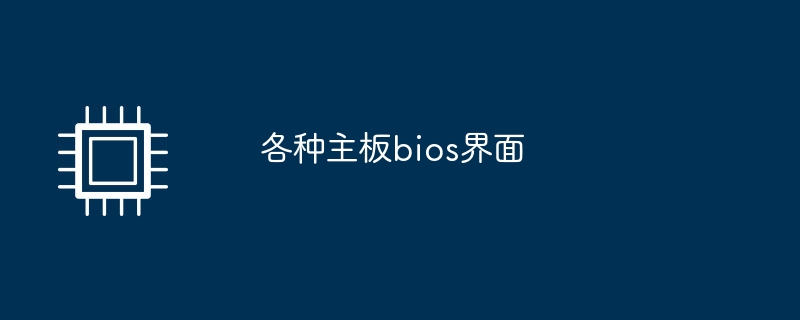

When the computer merchant icon appears on boot, press and hold the F2 key to enter the BIOS interface. Most computers hold down the F2 key, but some computer brands press F1 or other keys. When the above picture appears again, press the down key, select to enter the BIOS advanced settings, and then press Enter. In the BOIS interface, use the arrow keys to select, the Enter key to confirm, and the ESC key to return.
First shut down and power off, connect various devices and press the power button to enter the boot interface; press the "Delete" key when the system starts, or press the "F2" key or "F10" key. You can enter the BIOS setting interface; after entering the BIOS, you can see the corresponding setting prompts on the screen.
First start the computer, then select and press the F2 key in the startup interface to enter the bios interface, as shown in the figure below. After entering the bios interface, select and click the "Boot" option in the upper right corner, as shown in the figure below. Then in the pop-up menu bar, find the name of the solid-state drive and press Enter to select it.
Intel motherboard bios settings detailed explanation: Take the Lenovo Y460 notebook I use as an example: when booting, press F2 to enter the BIOS menu. The first thing you enter is the computer information menu bar, which includes computer model, BIOS version, and major hardware information such as CPU, memory, hard disk, and optical drive. The relevant information is as shown below: The picture below is the hardware configuration settings.
Intel 845ep motherboard bios setting method: right-click the file and select Use WinRAR. After opening the compressed file, extract the file to the corresponding folder, which should contain the SW.EXE file; then double-click SW. EXE to extract other files, including .BIO and .ITK files.
First, start the computer, press the shortcut key to enter the bios interface, switch to the boot option, select "hard drive order", and press Enter to confirm. Please click to enter the picture description 2 Then, in the pop-up option box, select the name of the USB disk and press Enter to complete the above operation and press F10 to save the settings.
1. Method 1: Use keys to enter the BIOS when the system starts. Most computers support using keys to enter the BIOS when the system starts. Different brands of computers may require different keys, but usually you can enter the BIOS setup interface by pressing any of the following keys.
2. There will be a screen prompt shortly after booting. Then press F2 according to the prompt to enter the BIOS interface. You can also press F12 and select "BIOS SETUP" in the menu to enter.
3. Then, here are some common ways to set the BIOS entry method. When pressing specific keys to set up the BIOS, we You need to enter the BIOS by pressing a specific key. In fact, this specific key is provided by the computer manufacturer. These keys include FFFEsc, Delete, etc.
4. Press and hold the relevant Del key to enter when turning on the computer. BIOS. Make related settings. BIOS is the abbreviation of Basic Input Output System in English. The translated meaning is the basic input and output system. Basically, some of the most important output programs and system setting information of the computer are saved by this software. .
1. Desktop computer: Enter the BIOS setting keys: DEL, ESC, F1, F2, F8, F9, F10, F12 .
2. Press the power button to turn on the computer. When "Press DEL to enter EFI BIOS SETUP" appears at the bottom of the startup screen, press Del to enter the BIOS setup process. Turn on the computer. When "Press Esc to enter" appears at the bottom of the computer screen. enter SETUP", immediately press Esc to enter the BIOS setup process.
3. (The corresponding keys are different depending on the computer motherboard. Please refer to the table below for details) BIOS key DEL key: The most common key is "DEL ", this type of computer is mainly based on AwardBIOS and AMIBIOS. Desktop computers basically enter the BIOS by pressing the DEL key during startup.
4. When turning on the computer power, press and hold F2 on the Lenovo computer button. At this time, you can see on the computer screen that you have entered the BIOS interface, and all you can see are English letters.
5. There are several ThinkPad models that require you to hold down "F1" at the beginning without letting go. Enter the BIOS. And the remaining IBM, Toshiba and other brands need to press the "F1" key when booting. F10 key: Compaq computers need to press "F10" when booting to enter the BIOS. At this time, the screen will display "to BIOS Setup".
1. You can purchase the motherboard battery to replace it, then turn on the computer and press the DEL key (F2 or other designated hotkeys for notebooks) to enter the BIOS interface, and restart Set the correct parameters, and finally press F10 to save, exit and restart. Configuration error: This situation may also occur due to manual configuration of BIOS parameters that are inconsistent with the local hardware environment.
2. Hello, it is recommended to replace the motherboard battery. Thoroughly clean the computer from dust.
3. The computer automatically enters the bios as soon as it is turned on. The solution is as follows: Reason 1: Your BIOS battery is out of power. Solution: Just replace the battery. Reason 2: There is no floppy drive but the floppy drive is enabled.
The above is the detailed content of Various motherboard bios interfaces. For more information, please follow other related articles on the PHP Chinese website!




